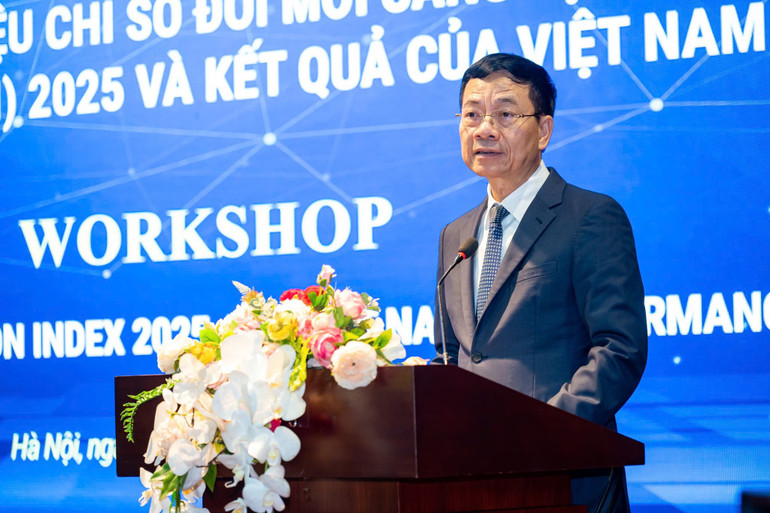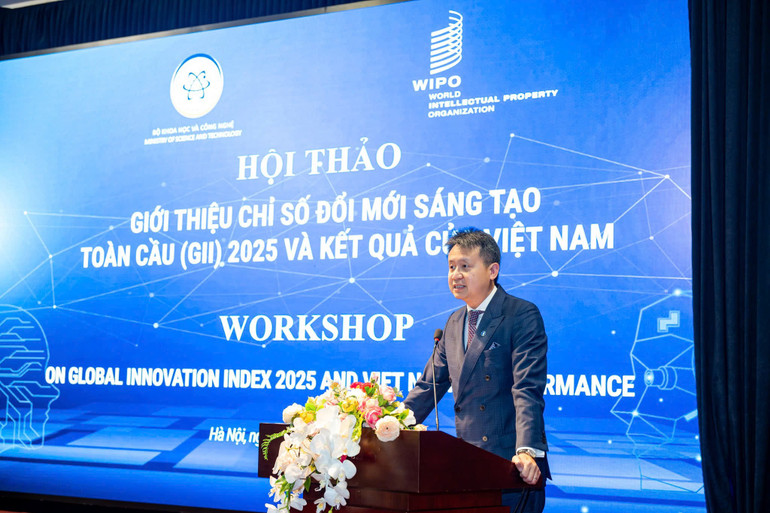
The workshop provided information on the GII 2025 report, methodological adjustments, the significance of the index, innovation trends and Vietnam's prospects in the coming years.
Speaking at the opening of the workshop, Minister of Science and Technology Nguyen Manh Hung emphasized that Vietnam's innovation must be innovation for all people. Innovation must bring science and technology to touch, change and solve practical problems in Vietnam, forming a spirit of innovation among all people, making innovation a way of life, a lifestyle of all people, of all organizations, forming a start-up nation based on digital technology, based on innovation.
The Minister also said that GII is a comprehensive set of innovation indicators, looking at which we can know how to improve Vietnam's innovation capacity. Guiding and analyzing the meaning of each indicator will help Vietnam have a clear basis to improve its capacity, contributing directly to the goal of sustainable development.

Minister Nguyen Manh Hung also proposed that WIPO implement a program to support Vietnam in upgrading its GII ranking, aiming to enter the global top 30 in GII in the next 5-10 years. This is a challenging goal, requiring the concerted efforts of the entire political system, the science and technology community and businesses.
To continue improving Vietnam's position on the GII rankings, Minister Nguyen Manh Hung proposed four key groups of solutions:
Firstly, perfecting the institutions and environment for innovation. Vietnam needs to remove legal barriers, financial mechanisms, and intellectual property; at the same time, encourage businesses to boldly invest in research and development (R&D) and apply new technologies.
From now until the end of the year, three important laws, the Intellectual Property Law, the Technology Transfer Law and the High Technology Law, will be amended to consider research results as assets that can be traded, valued, included in financial reports, and used as collateral for loans or capital contributions.
Second, invest in science, technology, innovation and digital infrastructure. Vietnam will build research centers, modern laboratories, supercomputers, open data systems and national interconnectivity – the fundamental foundations for breakthrough innovation.
Third, developing high-quality human resources. The policy will focus on innovating STEM education , promoting university-research institute-enterprise linkages, and attracting and utilizing domestic and foreign talent.
Fourth, promote innovation in enterprises. Enterprises must be the center of the innovation ecosystem. The State will accompany with financial support programs, venture capital funds, research ordering mechanisms and public procurement priorities for new products.

WIPO Director General Daren Tang highly appreciated Vietnam’s strong progress. He said that Vietnam has set an ambitious goal of becoming an upper-middle-income industrialized country by 2030 and a high-income country by 2045. To achieve this, innovation and intellectual property will be key, with Resolution 57 playing a guiding role, turning science, technology and innovation into a central driving force for development.
According to the GII 2025 report, Vietnam ranked 44/139 economies, 2/37 in the lower middle-income group and 9th in the Southeast Asia, East Asia and Oceania regions. Notably, Vietnam has always maintained outstanding performance compared to its income group over the past decade.
A series of indicators show outstanding strengths such as the proportion of high-tech import and export in trade, export of creative goods, labor productivity growth, mobile application innovation, etc.
One of the important reasons for Vietnam’s outstanding performance is its governance. Since 2017, the Government has considered the GII as a management tool and has continuously proposed solutions to improve each index.
In addition, Vietnam has "localized" the GII into the Provincial Innovation Index (PII), helping localities self-evaluate and compete fairly; at the same time, promulgating intellectual property policies that are closely linked to innovation.
At the workshop, Mr. Sacha Wunsch-Vincent, a WIPO expert, also made recommendations to help Vietnam continue to improve its GII ranking, focusing on five pillars: Investing more and more effectively in R&D; building a close link between science and industry; moving from “assembly” to proactive production; developing a startup ecosystem and growth finance; forming and managing intangible assets well to attract value.
Source: https://nhandan.vn/doi-moi-sang-tao-la-dong-luc-de-viet-nam-nang-hang-gii-post910558.html


![[Photo] Panorama of the cable-stayed bridge, the final bottleneck of the Ben Luc-Long Thanh expressway](https://vphoto.vietnam.vn/thumb/1200x675/vietnam/resource/IMAGE/2025/9/30/391fdf21025541d6b2f092e49a17243f)
![[Photo] Solemn opening of the 12th Military Party Congress for the 2025-2030 term](https://vphoto.vietnam.vn/thumb/1200x675/vietnam/resource/IMAGE/2025/9/30/2cd383b3130d41a1a4b5ace0d5eb989d)
![[Photo] The 1st Congress of Phu Tho Provincial Party Committee, term 2025-2030](https://vphoto.vietnam.vn/thumb/1200x675/vietnam/resource/IMAGE/2025/9/30/1507da06216649bba8a1ce6251816820)

![[Photo] General Secretary To Lam, Secretary of the Central Military Commission attends the 12th Party Congress of the Army](https://vphoto.vietnam.vn/thumb/1200x675/vietnam/resource/IMAGE/2025/9/30/9b63aaa37ddb472ead84e3870a8ae825)
![[Photo] President Luong Cuong receives President of the Cuban National Assembly Esteban Lazo Hernandez](https://vphoto.vietnam.vn/thumb/1200x675/vietnam/resource/IMAGE/2025/9/30/4d38932911c24f6ea1936252bd5427fa)
























































































Comment (0)